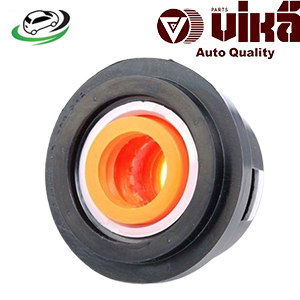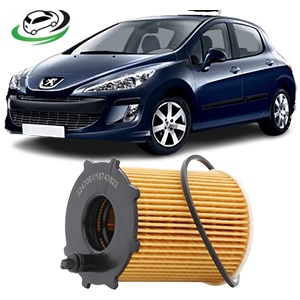-13%
Get Peugeot 308 Oil Filter Sub Assy 07Z115562
The oil filter sub assembly is a complete unit that houses the oil filter and related components, ensuring the proper filtration of engine oil as it circulates through the engine. It consists of several parts, including the oil filter, oil filter housing, and seals or gaskets. The oil filter’s primary function is to trap dirt, metal particles, carbon deposits, and other contaminants that may accumulate in the engine oil over time. This helps maintain the cleanliness of the oil and ensures the longevity and efficient performance of the engine.
The oil filter sub assembly is typically mounted on the engine block, and its design allows easy access for replacing the oil filter during routine maintenance.
2. Functions of the Oil Filter Sub Assembly
The oil filter sub assembly serves several critical functions within a vehicle’s engine system. These functions are vital for engine longevity and efficiency:
2.1. Oil Filtration
The main function of the oil filter sub assembly is to filter contaminants from the engine oil. As the engine operates, various particles such as dirt, metal shavings, and carbon deposits may mix with the oil. If left unchecked, these contaminants can damage engine components, cause wear, and lead to engine failure. The oil filter captures these particles, allowing only clean oil to circulate through the engine.
2.2. Maintaining Oil Pressure
The oil filter sub assembly also helps regulate oil pressure within the engine. As the engine oil passes through the filter, the assembly ensures that the oil pressure remains consistent, providing adequate lubrication to all moving parts of the engine. Proper oil pressure is essential to prevent metal-to-metal contact, reduce friction, and maintain the overall health of the engine.
2.3. Cooling the Engine
By ensuring that clean oil flows smoothly through the engine, the oil filter sub assembly aids in the cooling process. The oil absorbs heat generated by the engine’s moving parts and carries it away, helping to prevent overheating. Clean oil also flows more efficiently, enhancing its ability to cool the engine.
2.4. Preventing Engine Wear
Contaminated oil can cause significant wear to engine components, such as the pistons, camshafts, and crankshafts. The oil filter sub assembly helps prevent this by removing harmful particles, allowing the oil to maintain its lubricating properties and reduce friction between moving parts.
3. Components of the Oil Filter Sub Assembly
The oil filter sub assembly consists of several parts, each contributing to the overall function of the system:
3.1. Oil Filter
The oil filter is the heart of the assembly and is responsible for trapping contaminants. Oil filters are typically made from paper or synthetic filter media, pleated to increase surface area and maximize filtration efficiency.
3.2. Oil Filter Housing
The oil filter housing encloses the filter and connects it to the engine’s lubrication system. The housing ensures that oil flows through the filter before reaching critical engine components. Some oil filter housings are made of metal, while others are constructed from durable plastics.
3.3. Bypass Valve
The bypass valve is a critical safety feature in the oil filter sub assembly. If the oil filter becomes clogged or if the oil is too thick (e.g., during cold starts), the bypass valve opens to allow unfiltered oil to bypass the filter and reach the engine. This ensures that the engine receives lubrication even if the filter is compromised.
3.4. Anti-Drain Back Valve
The anti-drain back valve is another important feature found in some oil filter assemblies. It prevents oil from draining out of the filter when the engine is turned off, ensuring that the oil filter remains filled with oil for immediate lubrication during the next engine start.
3.5. Seals and Gaskets
Seals and gaskets are used to prevent oil leaks at the connection points between the oil filter housing and the engine. Proper sealing is essential to maintaining oil pressure and preventing contamination from entering the lubrication system.
4. Types of Oil Filters in the Sub Assembly
There are several types of oil filters used in oil filter sub assemblies, each with specific features and applications:
4.1. Spin-On Oil Filters
Spin-on oil filters are the most common type used in many vehicles. They consist of a metal canister containing the filter media, which screws directly onto the engine block. These filters are easy to replace, as they can be unscrewed and replaced without dismantling the housing.
4.2. Cartridge Oil Filters
Cartridge oil filters are found inside a separate housing, which is usually mounted on the engine. Unlike spin-on filters, only the filter media needs to be replaced, while the housing remains in place. This design is becoming more popular for its environmental benefits, as it reduces the amount of waste generated during oil changes.
4.3. Magnetic Oil Filters
Magnetic oil filters use a magnet in addition to filter media to trap metallic particles from the oil. These filters provide extra protection for engines where metal wear is a concern, such as in high-performance or older vehicles.
5. Benefits of a Well-Maintained Oil Filter Sub Assembly
A properly maintained oil filter sub assembly offers several key benefits:
5.1. Extended Engine Life
By keeping engine oil clean and free from contaminants, the oil filter sub assembly helps extend the life of the engine. Clean oil reduces wear and tear on engine components, preventing costly repairs and ensuring reliable performance over the long term.
5.2. Improved Engine Performance
Clean oil ensures that the engine operates smoothly and efficiently. Proper lubrication reduces friction, allowing the engine to run at optimal performance levels. In contrast, contaminated oil can cause sluggish performance and decreased fuel efficiency.
5.3. Prevention of Engine Damage
Contaminants in the oil can cause significant damage to engine components, leading to issues like worn bearings, scored cylinders, and damaged camshafts. A functioning oil filter assembly prevents these contaminants from reaching critical parts of the engine, thereby preventing potential damage.
5.4. Cost Savings
Regularly maintaining the oil filter sub assembly can help vehicle owners avoid costly repairs and extend the intervals between major services. By ensuring the engine is well-lubricated and free from contaminants, owners can reduce the likelihood of expensive breakdowns.
6. Common Issues with Oil Filter Sub Assemblies
Although the oil filter sub assembly is a relatively simple system, several issues can arise if it is not properly maintained:
6.1. Clogged Oil Filter
Over time, the oil filter can become clogged with contaminants, reducing its ability to filter oil effectively. A clogged filter can lead to restricted oil flow, increased engine wear, and, in severe cases, engine failure. If the filter becomes too clogged, the bypass valve may open, allowing unfiltered oil to circulate through the engine.
6.2. Oil Leaks
Worn or damaged seals and gaskets in the oil filter housing can cause oil leaks. Leaking oil can reduce oil levels in the engine, leading to reduced lubrication and potential engine damage. Regularly inspecting the oil filter sub assembly for leaks can help prevent these issues.
6.3. Improper Installation
Improperly installed oil filters or housings can cause oil leaks, reduced oil pressure, and insufficient filtration. It is essential to follow the manufacturer’s instructions when replacing the oil filter and to ensure that all seals and gaskets are properly seated.
7. Maintenance Tips for Oil Filter Sub Assemblies
Regular maintenance of the oil filter sub assembly is essential for keeping the engine running smoothly and efficiently. Here are some key maintenance tips:
7.1. Regular Oil Filter Replacement
Most vehicle manufacturers recommend replacing the oil filter every time the oil is changed, typically every 3,000 to 7,500 miles, depending on the type of oil and driving conditions. Regular replacement ensures that the filter remains effective at trapping contaminants.
7.2. Inspect the Housing for Leaks
During routine maintenance, inspect the oil filter housing and surrounding areas for signs of oil leaks. Address any leaks promptly by replacing damaged seals or gaskets to prevent oil loss and potential engine damage.
7.3. Use High-Quality Filters
Always use high-quality oil filters that meet or exceed the vehicle manufacturer’s specifications. Inferior filters may not provide adequate filtration, leading to engine wear and decreased performance.
7.4. Check Oil Levels Regularly
Even with a properly functioning oil filter sub assembly, it’s essential to check the engine oil level regularly. Low oil levels can lead to insufficient lubrication, increased friction, and engine overheating.
8. Conclusion
The oil filter sub assembly is a vital component of the engine’s lubrication system, ensuring that the engine oil remains clean and free from harmful contaminants. By maintaining proper oil filtration, the oil filter sub assembly helps extend engine life, improve performance, and prevent costly repairs. Regular maintenance, including oil filter replacement and housing inspections, is essential to keep the engine running smoothly and efficiently.
Understanding the function and importance of the oil filter sub assembly allows vehicle owners to take proactive steps in maintaining their vehicle’s engine health, leading to better performance, increased reliability, and longer engine life.
Follow us on Facebook for more parts.




Reviews
Clear filtersThere are no reviews yet.